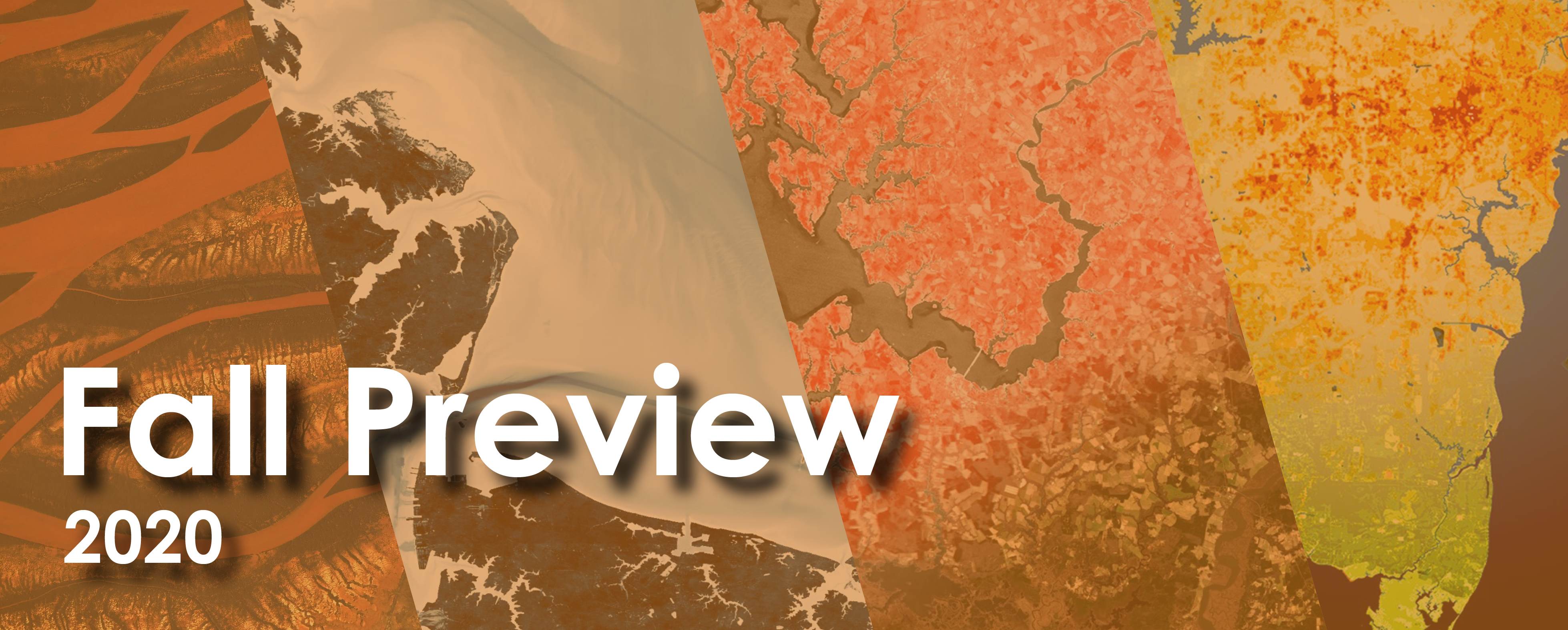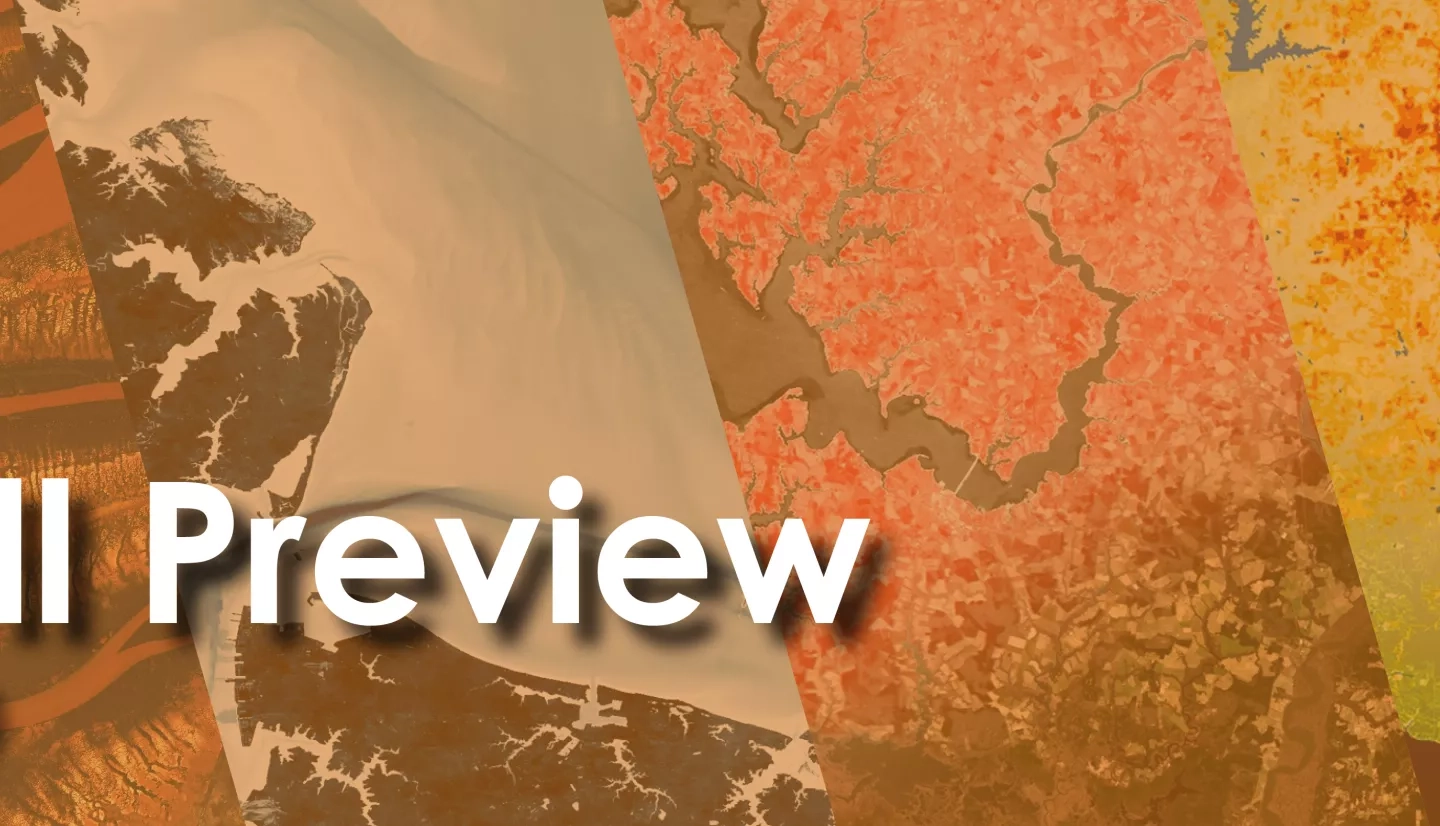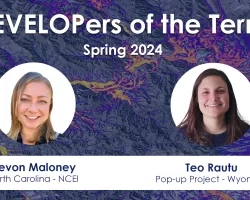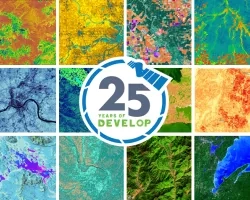
DEVELOP’s fall 2020 term began on September 14th and will conclude on November 20th. The DEVELOP leadership team welcomed 2 new Senior Fellows supporting national activities and 5 new Fellows supporting DEVELOP locations. The DEVELOP Program is conducting a program-wide Software Carpentry workshop again this fall, which includes training in Unix Shell, Git, and programming in Python and R. Forty-nine participants are working virtually from 19 states and Washington, DC. The participants are working on 12 projects in the areas of Disasters, Ecological Forecasting, Food Security & Agriculture, Health & Air Quality, Urban Development, and Water Resources. Learn more about the fall 2020 projects being conducted below!
The Alabama – Marshall DEVELOP team is working on the Amazonia Disasters project, which will use NASA Earth observations to detect gold mining-related deforestation in the Amazon. Artisanal and small-scale gold mining (ASGM) is responsible for a large fraction of forest loss and disturbance in the Amazon. Compared to other deforestation drivers, such as cattle ranching, agriculture, and selective logging, ASGM leads to loss of ecosystem services, removal of fine sediments, and decrease in water quality. Additionally, the use of liquid mercury for gold amalgamation not only causes severe impacts on the altered landscapes, but also negatively affects human health and incurs social costs. With a better understanding of the change detection methods that will assist current monitoring systems, more timely and accurate decisions can be made to temper illegal gold mining activities in the Amazon region. This project will determine the most effective algorithm in Google Earth Engine to assist partners in assessing information technology options available to them as they seek to create an early alert system for detecting gold mining activity over the study region. These methods are potentially applicable to other regions within Amazonia as well.
The Southern Colorado Disasters team from the Colorado – Fort Collins DEVELOP location will map the aspen (Populus tremuloides) extent after fire in southern Colorado to evaluate patterns of vegetation recovery. The western United States is facing a future with more frequent and severe wildfires. Communities are concerned about impacts on forests and the associated services they provide for water quality, wildlife, recreation, carbon storage, and the economy. Aspen is a species of particular interest to communities and managers, as it re-sprouts following disturbance and can be one of the first species to recover after fire. The quick re-establishment of aspen can help stabilize watersheds and provide important wildlife habitat. This project will provide valuable data to project partners to characterize post-fire forest recovery, the impacts of the Spring Fire on aspen distribution, and potential drivers of these changes. The products will provide comprehensive maps across this difficult to access terrain and will harness the temporal power of remote sensing to identify where aspen was distributed before the fire. This information has the potential to assist end users in better evaluating the impact of their forest management before and after the fire to promote aspen growth, one of their primary management objectives.
The Colorado – Fort Collins DEVELOP team is conducting the California & Oregon Ecological Forecasting project. Coast redwood (Sequoia sempervirens), the tallest tree species in the world, is currently distributed along a narrow strip of coastline stretching from Curry County, Oregon to Monterey County, California. While only a fraction of the species’ old-growth forests remains, second- and third-growth forests are actively being conserved and restored, and new conservation opportunities are actively sought. Recent research supports expanding climatic suitability of coast redwood at its northern range margin. However, species-specific predictors of environmental suitability, such as the current and future distribution of fog, an important source of moisture and nutrients, and the impact of recent disturbances, are not currently available or included in these analyses and projections. This project will increase understanding of the potential for northern range expansion of coast redwood under climate change. Project partners have requested habitat suitability projections to expand the information available to them to prioritize their conservation work, which includes property acquisition, restoration work, and research to protect and restore redwood forests. This work can inform where conservation and restoration activities and resources should be targeted.
The team from DEVELOP’s Virginia – Langley location is conducting the Sacramento Urban Development project. Sacramento is California’s fastest-growing large city in terms of population. The city wants to ensure that this growth is sustainable, equitable, and inclusive. The city also hopes to better adapt to the urban heat island effect. Some crucial steps include strategically prioritizing the implementation of green infrastructure, particularly in neighborhoods with a high proportion of vulnerable populations susceptible to heat-related illness or death. A spatial analysis of temperature disparities during peak summer months will provide the project partner’s planning team information that may assist them in recognizing the implications of these interventions and prioritize areas of the city that are home to a high proportion of vulnerable populations or are most likely to experience rapid growth.
The Tempe Urban Development II team from the Tempe – Arizona DEVELOP location will quantify the urban heat effects of roads and parking lots in Tempe, Arizona through analysis of NASA Earth observations and in situ data. Urban heat is an important issue in Tempe, Arizona, with hundreds of heat deaths and thousands of heat-related hospitalizations reported in the last fifteen years. Municipalities around the city have competing interests and infrastructure priorities, which has made heat mitigation efforts challenging. The city is hoping to compile a heat intervention prioritization map using both micro-scale and macro-scale observations of factors that impact experienced heat. This work will provide Tempe information that may assist them in addressing heat mitigation goals, as they seek to target their efforts in the hottest parts of the city. The Earth observation measurements and LiDAR-based shading analysis will expand the partner’s knowledge of experienced heat from their current discrete ground-based measurements. By simplifying the factors that contribute to urban heat into a four-tiered system of heat exposure severity, they will clarify prioritization needs across city departments.
The Africa Food Security & Agriculture team from the Georgia – Athens location will determine human-elephant conflict areas and elephant habitat conditions during extreme drought and crop deficit. This project studies human-elephant conflict within the African Kavango-Zambezi Transfrontier Conservation Area, where drought increasingly brings free-ranging elephants from national parks to developed areas. In these areas, they threaten residents, damage property, eat refuse from landfills, and raid the crops of subsistence farmers. Products analyzing urban/agricultural expansion, habitat condition, and crop health during drought will provide information to partners that can potentially assist them with protecting elephant corridors, making recommendations to local decision makers, and fostering coexistence between agricultural lands, landowners, and elephants.
The Idaho – Pocatello DEVELOP team is working on the Southern Idaho Health & Air Quality project to assess mixing heights in the lower atmosphere for wildfire management in Idaho. Wildfires have increased in frequency across the United States since 1950. These fires damage landscapes and infrastructure and have long-term effects on human health due to smoke and ash spreading long distances from a fire source. The National Weather Service monitors smoke and ash plumes mixing heights in the atmosphere and predict travel trajectories. Past fires are used as an analog for predicting smoke expulsion from future fires. The products created by the DEVELOP team will assist partner organizations learn about methods that can potentially be adopted to better allocate resources to issue air quality warnings.
The Central Valley Water Resources II team from the California – JPL DEVELOP location is looking to improve California groundwater depletion and land subsidence assessments using GRACE and InSAR datasets for water resource management. California’s Central Valley has been acutely affected by widespread droughts, causing groundwater depletion and land subsidence. These factors endanger local communities, and the country as a whole, as the Central Valley is one of the nation’s most productive agricultural areas. This project will provide the California Department of Water Resources (DWR) with information that can potentially be adapted to assist in building a water storage change dataset in the Central Valley, which is intended to supplement rural areas without in situ data. The DWR will have additional information available to them as they seek to verify Groundwater Sustainability Agencies’ sustainability claims.
The team from the Massachusetts – Boston DEVELOP location is working on the Charles River Basin Water Resources project, which will identify vulnerable communities in the Charles River Basin to assist flood intervention and management programs. When surveyed, town representatives in Massachusetts cited flooding as one of their greatest environmental concerns. Recent flooding has been attributed to increased development, impervious surfaces, and extreme weather events. Many local governments and organizations are interested in assessing their area’s vulnerability to flooding and the impact of increasing impervious surfaces on local water quality. Partners will be provided water quality maps, as well as flooding vulnerability, susceptibility, and frequency maps that will assist them in addressing resiliency efforts. Results have the potential to inform ongoing flood risk modeling, as remote sensing has previously not been incorporated. Partners will better recognize the scope of environmental concerns when they work with neighboring governments and groups to help create a watershed-wide plan for how Charles River Watershed communities will prepare for future flood events.
DEVELOP’s California – Ames Hawaii Water Resources project is utilizing NASA Earth observations to monitor harmful algal blooms off the Hawaiian Coast. The Papahānaumokuākea Marine National Monument has experienced the arrival and development of a previously undescribed algal species, Chondria tumulosa, which has begun to kill vast extensions of coral reefs. Based on the rapid rate of spreading, local managers predict the invasion of other atolls within the monument and potential invasion of the main Hawaiian Islands’ reefs within the next year. End products will assist in understanding past environmental patterns that may be related to algal growth, as well as assess ocean conditions to detect potential phase shifts in the monument’s atolls, and therefore inform coral conservation efforts.
The North Carolina – NCEI DEVELOP team is conducting the Montana Water Resources project, which will develop vegetation health and water balance anomalies for the drought indicators dashboard for Montana and the Upper Missouri River Basin. Montana and the U.S. Northern Plains experience cycles of moisture surplus and deficit. For example, 2017 summer drought conditions were driven by unpredicted and record low spring rainfall coupled with rapid soil moisture decline, resulting in wide-spread wildfires and an estimated $2.6 billion in agricultural losses. A Composite Moisture Index focused on October-March can provide context of antecedent conditions and relative moisture availability at the start of the growing season. Anomalies of soil moisture, groundwater, & land surface temperature, as well as snowmelt potential, can show a convergence of evidence of drought indicators.
The Gila Water Resources II team from the Maryland – Goddard DEVELOP location will assess the impact of post-fire restoration efforts on flash floods in Gila National Forest to inform post-fire decision making. Recent wildfires in New Mexico’s Gila National Forest have significantly affected the landscape and stream dynamics in the forest. For the Gila National Forest land managers, how to spend fire resources is constantly in question. While the restoration team uses several methods for restoring vegetation post-fire, the comparative success of these methods is unknown. The partners could benefit from a tool that allows them to understand the likelihood of vegetation regrowth for each post-fire restoration technique they use. This project will help inform the partner’s selection of fire recovery treatments as they seek to collect as much information as possible to assist them in allocating resources efficiently to maximize recovery rates.



